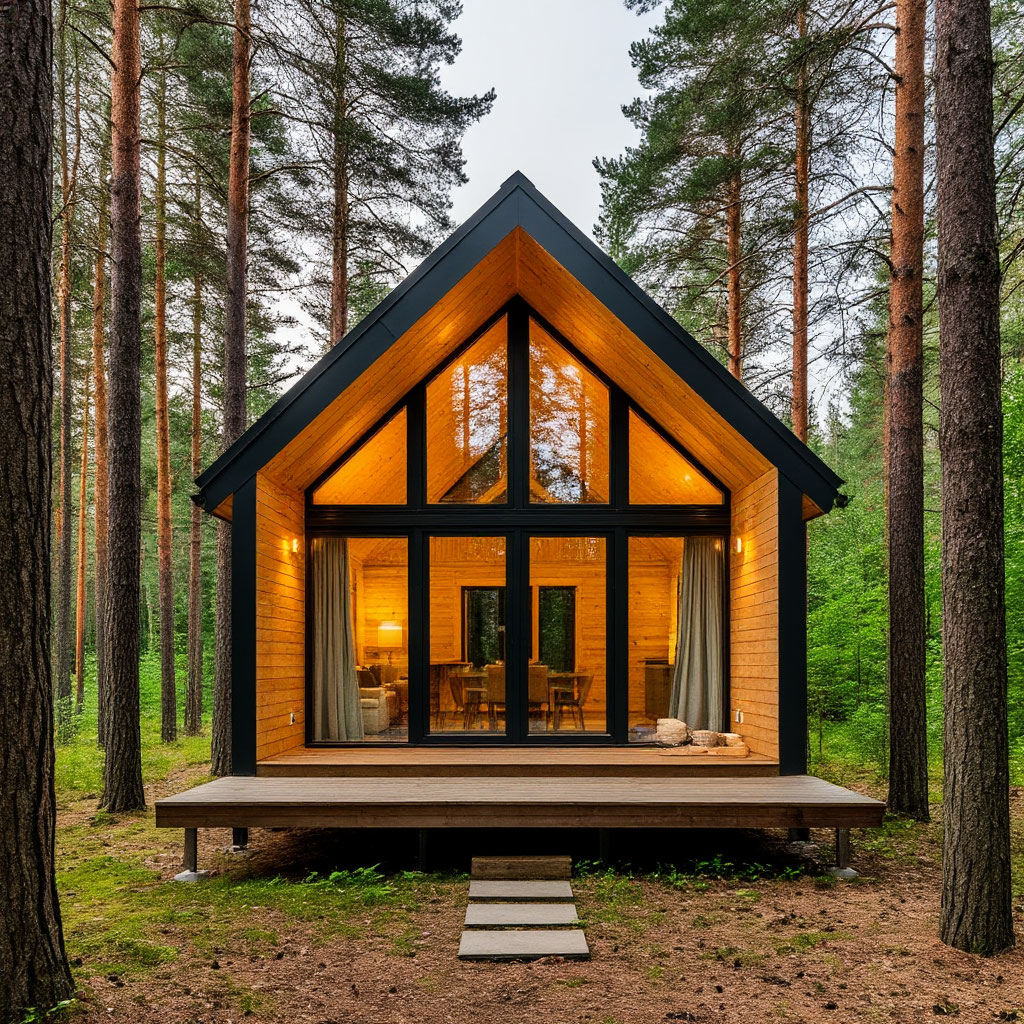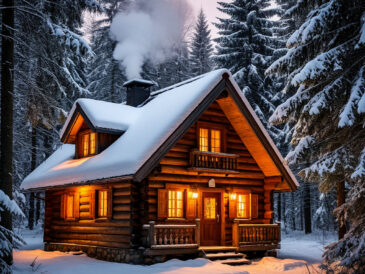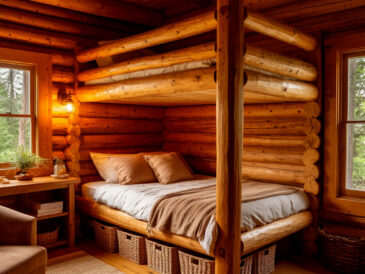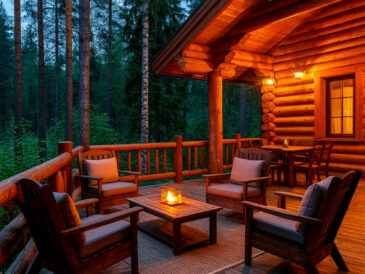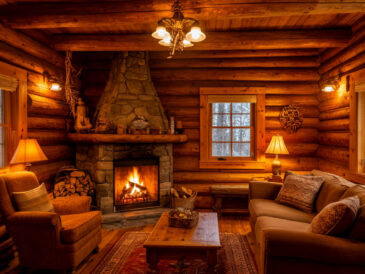Contents
- 1 Why Forest-Inspired Designs Matter for Cabin Living
- 2 Choosing Eco-Friendly Materials for Your Cabin
- 3 Incorporating Forest Design for Sustainable Living
- 4 DIY Projects to Bring the Forest Inside
- 5 Maintaining Sustainability in Forest Cabins
- 6 FAQ
- 6.0.1 Can I legally live full-time in an off grid forest cabin with solar and a composting toilet?
- 6.0.2 Will my forest cabin grow mold and rot because it’s always shaded and damp under the trees?
- 6.0.3 How much does a sustainable forest cabin cost per square foot compared to a normal house build?
- 6.0.4 Will bears and other wildlife get into my eco cabin if I compost food scraps and store trash outside?
- 6.0.5 Is a wood stove in a small forest cabin a wildfire risk in dry season?
Living in the woods isn’t just about escaping city noise. It’s a shift into a different rhythm of life. Forest design for sustainable living blends style and comfort with respect for nature. This approach works especially well for cabins. These homes connect us to the outdoors and make sustainability feel natural. Whether it’s morning fog drifting through the trees or the hush of snowfall outside, a forest-inspired cabin supports a grounded lifestyle. From layout to materials, every detail should echo the woods around it.

Why Forest-Inspired Designs Matter for Cabin Living
A forest setting changes the way a home feels. It’s not just about beauty. Trees provide a living microclimate. They shade your cabin in the summer and block winds in winter. That balance helps control indoor temperatures naturally. Forest-inspired cabin décor uses these surroundings as part of the design, instead of working against them.
Living near trees also improves well-being. Studies show lower stress and better sleep for people surrounded by greenery. Even the scent of pine or cedar calms the nervous system. That’s why green cabin living has grown in popularity. When your home aligns with the forest, your daily life tends to slow down. Meals become quieter, mornings more mindful.
Cabins built with the forest in mind often include large windows. They let light pour in and make you feel part of the landscape. Natural airflow improves with smart layout. Ventilation gets a boost when the home follows the land’s natural curves. These choices aren’t just aesthetic. They support a more peaceful and practical lifestyle.
Forest-inspired cabin décor doesn’t mean rustic or rough. It’s about tone. Think soft bark colors, worn wood surfaces, and natural patterns. Your walls might carry the grays of lichen, your furniture the lines of old tree rings. Even lighting can echo the way sunlight filters through branches. In the end, the forest isn’t a background. It becomes part of your daily rhythm.

Choosing Eco-Friendly Materials for Your Cabin
When it comes to building a cabin, materials matter. Eco-friendly choices can lower your impact and boost the life of your space. Sustainable cabin design starts with what goes into the structure.
Natural woods are a smart pick. Cedar resists rot. Pine brings warmth. Reclaimed timber adds history without cutting fresh trees. These options blend with the forest and wear well over time.
Stone is another classic choice. Recycled or local stone helps lower transportation emissions. It’s sturdy, weather-resistant, and fits into green cabin living goals. Using it for your fireplace or walkway brings weight and grounding energy to the space.
Windows deserve extra attention. Double or triple glazing keeps heat inside and drafts out. Wood or composite frames last longer and perform better than plastic ones. Look for ENERGY STAR ratings or local certifications.
Some other eco-friendly cabin materials to consider:
- Sheep’s wool insulation. It’s breathable, renewable, and doesn’t irritate the skin.
- Linseed oil sealants. These preserve wood without toxic off-gassing.
- Low-VOC paints. These protect indoor air without harsh chemicals.
- Bamboo or cork flooring. These grow fast and hold up to wear.
- Salvaged metal details. Hinges and handles with character add charm.
Building with purpose keeps your design honest. Sustainable cabin design doesn’t have to feel hard or limiting. It becomes easier when the materials reflect the values behind them. Durability and comfort work together when the forest helps guide the process.

Incorporating Forest Design for Sustainable Living
Forest design isn’t a trend. It’s a method rooted in observation. When cabins respond to their setting, everything starts to align. That’s where forest design for sustainable living comes into play. It helps your home thrive alongside the land.
Structural Elements that Mirror the Landscape
Wooden beams speak the language of trees. Exposed rafters show off grain and form. Using timber for ceiling lines or stair rails ties the indoors to the woods. These details ground the interior. It feels like your home is built from the same source as the trees outside.
Verandas play a quiet but powerful role. A porch facing a stand of pines becomes more than a place to sit. It’s part of the daily rhythm. Coffee at sunrise, a book in the afternoon, or just watching the wind move through branches—all of it adds up. When designed well, verandas protect your walls and cool your cabin naturally.
Letting in the View
Big windows aren’t just for light. They frame the forest. Floor-to-ceiling glass creates a canvas of nature that shifts with the seasons. Each storm, each bloom becomes part of your decor. Positioning matters. North-facing windows avoid glare and overheating. South-facing ones can warm up chilly rooms in winter.
Even simple features can make a difference. Skylights open small cabins to the sky. Sliding glass doors blur the edge between indoors and out. Every surface that reflects nature becomes part of a quieter, more grounded routine.
Table: Features That Define Forest Design
| Element | Purpose | Sustainable Benefit |
| Exposed Wood Beams | Adds warmth, connects to surroundings | Locally sourced wood reduces carbon |
| Wraparound Veranda | Outdoor living, natural shade | Reduces need for air conditioning |
| Large Picture Windows | Views, passive solar heat | Lowers lighting and heating needs |
| Natural Stone Walls | Durable, blends with setting | Low maintenance and energy-efficient |
| Wood-Burning Stove | Focal point, off-grid option | Reduces electric heating demand |
For more ideas about using evergreen trees and native forest landscapes in your design, check out this resource on forest design for sustainable living.

DIY Projects to Bring the Forest Inside
Cabins feel more alive when built with care. Forest-inspired décor doesn’t have to come from high-end stores. You can make it with your hands and time.
Crafting brings personality into a space. A shelf cut from a tree slice keeps the grain visible. A fireplace faced with river stones holds memories of hikes. Even a bark-covered divider can shape a room’s flow.
Woodworking doesn’t require a full shop. A few tools and some patience go a long way. Making your own furniture gives you control over every finish. You avoid harmful glues and synthetic coatings. Instead, you use wax or plant oils. These let wood breathe and age with beauty.
Some favorite DIY cabin projects:
- Tree-slice shelves. Natural edges keep the wild shape of the log.
- Stone hearths. Gather local rock to create a one-of-a-kind fire feature.
- Spruce bark partitions. Soft lighting glows against rough textures.
- Branch hooks. Hang coats or mugs on curved limbs.
- Moss art panels. Bring green inside without constant care.
These ideas don’t need a massive budget. Forest-inspired décor works best when it tells a story. When you’ve shaped something with your own hands, it becomes more than an object. It holds your time and focus. That energy lasts.

Maintaining Sustainability in Forest Cabins
Once your cabin is built, keeping it green takes steady habits. Sustainable cabin living means staying thoughtful through the seasons.
Wood needs protection. Rain, sun, and snow take their toll. Regular oiling helps beams and siding last longer. Choose treatments made from natural sources. Beeswax and citrus oils do the job without toxins.
Managing energy starts with awareness. Thick curtains trap heat. Cross-breezes cool down rooms without fans. LED lighting cuts demand without dimming the mood. Tiny changes add up when repeated daily. Your roof choice affects maintenance and embodied energy. See our metal vs shingle roof comparison for lifespan and cost trade-offs.
Dealing with waste matters too. Forest cabins often lie far from pickup routes. Composting helps turn scraps into soil. Reusing gray water for plants keeps more in the system. Storage bins reduce clutter and make recycling easier.
Here are a few daily maintenance habits:
- Use wood ash from your stove to enrich garden soil.
- Dry clothes in the sun instead of using a machine.
- Collect rainwater for outdoor cleaning.
- Turn off standby devices to cut energy use.
- Store food in jars instead of plastic.
Low-waste cabin maintenance doesn’t require big changes. It grows through attention. Forest life tends to slow the mind. That makes room for these small acts. Over time, they shape the way your home works.
FAQ
Can I legally live full-time in an off grid forest cabin with solar and a composting toilet?
Yes, in many places you can live year-round in an off grid forest cabin with solar and a composting toilet. Counties usually care about zoning (is housing allowed) and approved sanitation. A composting toilet often needs to meet health code, and gray water can’t just dump downhill. Call the county building and health departments before you move in so you don’t get tagged as an illegal dwelling.
Will my forest cabin grow mold and rot because it’s always shaded and damp under the trees?
Yes, it can if you ignore moisture. Forest cabins shaded by trees stay cooler, but trapped humidity can cause mold, rot, and carpenter ants. You prevent that with airflow, raised foundations, gutters, and vented roofs. Run a small dehumidifier or fan-draw cross breeze after rain and you’ll cut most of the risk.
How much does a sustainable forest cabin cost per square foot compared to a normal house build?
Most people spend about $200–$350 per square foot to build a sustainable forest cabin with good insulation, high-efficiency windows, and locally sourced wood. Super basic shells can land closer to $120–$180 per square foot if you DIY and skip plumbing finishes. Off-grid systems like solar, water storage, and composting toilet usually add $10,000–$25,000 upfront. Budget the site work too — road, clearing, septic or cistern can easily match the first $15,000 you planned.
Will bears and other wildlife get into my eco cabin if I compost food scraps and store trash outside?
Yes, wildlife will show up if your eco cabin smells like food. Bears, raccoons, and mice read compost as dinner, not sustainability. Use sealed bear-rated bins and freeze meat scraps instead of tossing them warm. Keep trash and pet food locked inside a hard container, not on the porch.
Is a wood stove in a small forest cabin a wildfire risk in dry season?
No, a code-installed wood stove in a small forest cabin is not automatically a wildfire starter, but you still have to manage sparks. Use a proper chimney with spark arrestor and keep roof needles cleared. Store firewood at least 10 feet from exterior walls, never stacked under the eaves. Also keep a fire extinguisher and metal ash bucket with a lid, not a cardboard box. A compact wood stove can be clean, safe, and highly efficient when installed correctly. Follow this wood stove installation guide for clearances and venting.
Designing a forest cabin is more than picking a look. It’s about listening to what the landscape asks. Forest design for sustainable living brings balance between beauty and function. You don’t have to choose between style and care for nature. With the right materials,
